Archaeological finds of Roman jewelry are relatively rare considering the magnitude of the Roman civilisation, its duration and its vast Empire. It is hidden hoards of jewelry and individual finds that account for most of the items we can observe today. The hoards would have been items that were stashed away for safekeeping, or maybe as votive offerings. The individual pieces are often just lost items. Loose ring stones, for instance, have been found in the sewers of Roman bathhouses.
Roman Heritage
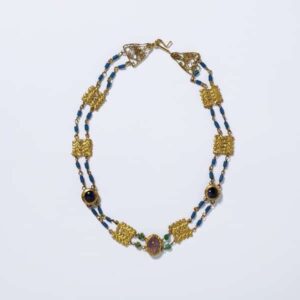
Victoria & Albert Museum Collection.
The two sites of Herculaneum and Pompeii form the exception to the rule. The excavations of the two towns account for the largest part of 1st-century Roman jewelry that has been preserved. In Rome cremation was the way to dispose of the deceased. Consequently, unlike the Egyptian richly decorated graves and Etruscan urn burials which provide us with perfectly preserved jewelry, we have to do without grave finds. A situation which, fortunately, is made up for by historical sources. Roman writers were among the first to create a vivid picture of their civilisation, their knowledge, fashion and craftsmanship through the written word. The 1st-century author Gaius Plinius Secundus a.k.a. Pliny the Elder forms an excellent example. He discussed the use, history, and properties of gold, jewelry and precious stones in his writings named Naturalis Historia so that we can enjoy seeing the Roman world through the eyes of a Roman.
Early Rome
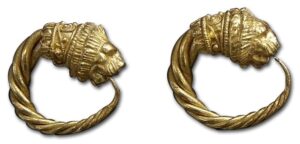
Being under the influence of the Etruscans, the early Romans must have seen the splendid examples of the artists created by their northern neighbors. Yet, examples of Roman jewelry from this early period (7th-1st century BC) are extremely rare. Gold was very scarce and the little gold that existed was used for trading and warfare rather than personal adornment. The use of gold in jewelry was officially discouraged.
Imperial Rome
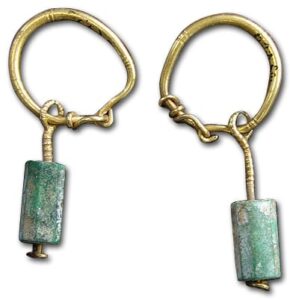
Things changed dramatically after the annexation of the Greek world. The use of jewelry in Roman society became popular fast with most of their items resembling that of the Hellenistic style. Gradually appearance of Roman jewelry developed into a genre of and emerald crystals]] its own during the Imperial Era. Western Asian, Egyptian, and other cultures were of great influence. One example is the extensive use of hard gemstones which was adopted from the Etruscans who sporadically had used Sri Lankan sapphires in their jewelry, something that became more common in Roman pieces. Garnets were also popular as were the newly discovered emeralds from Egypt. These were often left to present their natural hexagonal form only with a hole drilled down the length so that they could be strung. The first diamonds appear in these pieces as well. At the beginning of the imperial period, the emphasis lay on the goldwork but gradually the importance of stones became such that less effort went into the gold settings and more into the actual stones.
Other innovations are that of opus interrasile, a technique where delicate patterns are cut out of the gold with the aid of a chisel, and the introduction of niello: a black composition of metal sulfides that forms a clear contrast with the underlying gold or silver. Inlay, as seen in Egyptian jewelry, is encountered as well: colored stones or glass were attached into cloissons with the aid of an adhesive.
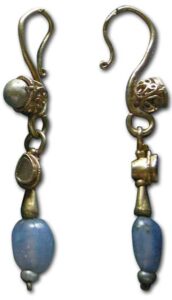
Finds from Pompeii and Herculaneum illustrate the fashion of the first century: distinctive bracelets containing paired gold spheres linked together to form a broad band of double domes with matching earrings. Dangling earrings of gold wire with gemstones suspended from them were popular too. From Pliny’s writings and portraits from those days, we can state that serpent rings and bracelets were highly fashionably, as were gem-set necklaces, s-shaped pearl earrings. Rings became very popular, much to Pliny’s disgust. Rings were often simple bands with a single engraved seal stone or a coin but purely decorative rings set with gemstones all around have been found to. In addition, more extraordinary rings that acted as keys and rings that covered several fingers were developed.
Roman lapidaries produced some extremely fine engraved stones. Superb cameos have been found, both directly from Roman times and, on numerous occasions, in Medieval settings. Amber and jet were imported from the conquered territories in the north, often already worked by the inhabitants of the provinces.
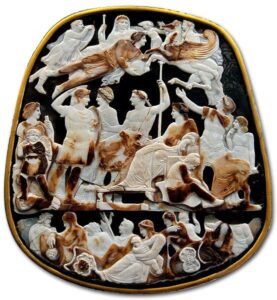
Goldsmiths seem to have been organized in guild-like organisations much like their Medieval successors. The main production centres in the Roman world were Rome itself, Antioch and Alexandria. The skills of the goldsmiths appear to be of lesser sophistication than those of the Hellenistic world.
Roman jewelry dispersed all through the Roman world, influencing numerous cultures. The wealthy inhabitants of northern Europe, the Celts started to consider the Roman way of life as fashionable and consequently adopted many aspects of Roman jewelry making. Vice versa the Romans started using some typically Celtic materials like jet.
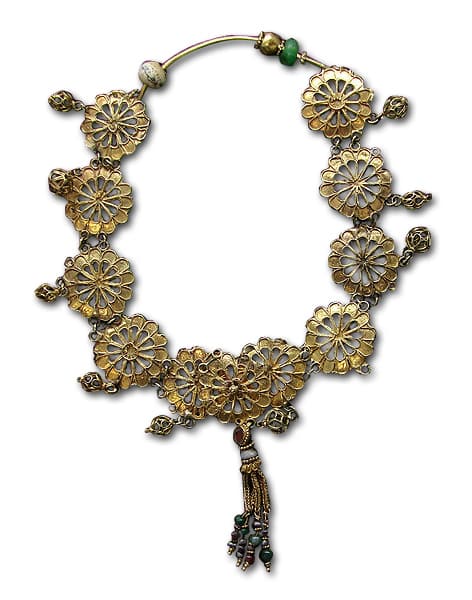
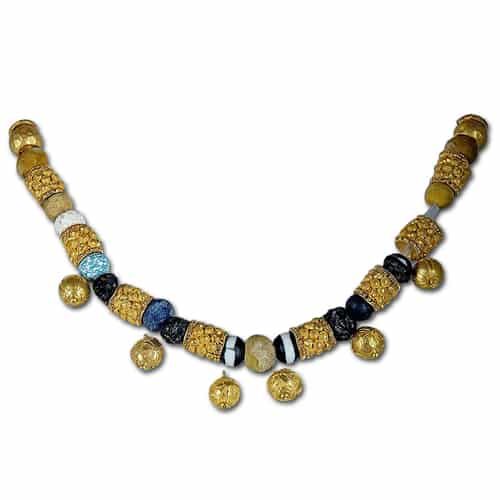
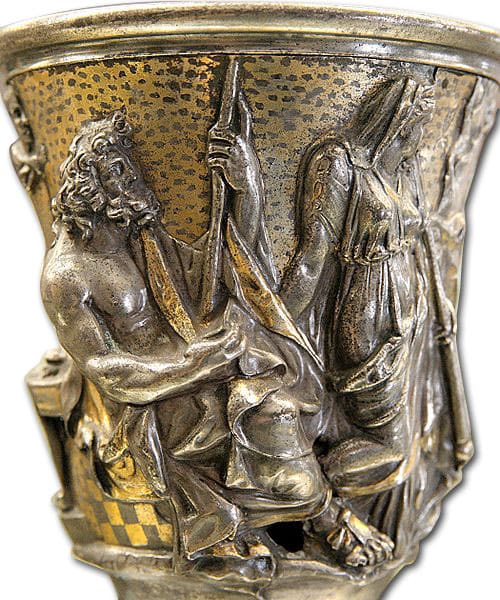
Pliny
The 1st-century Roman author Gaius Plinius Secundus has left us an impressive work in the form of his life’s work: Naturalis Historia. His writings are so important because it gives us an insight into who wore what jewelry and why, something archaeological excavations only do to a certain extent. Below follow relevant fragments from an 1855 translation of his book on the origin and use of rings in the Roman world in the 1st century AD:
The worst crime against mankind was committed by him who was the first to put a ring upon his fingers: and yet we are not informed, by tradition, who it was that first did so. For as to all the stories told about Prometheus, I look upon them as utterly fabulous, although I am aware that the ancients used to represent him with a ring of iron: it was their intention, however, to signify a chain thereby, and not an ornament. As to the ring of Midas, which, upon the collet being turned inwards, conferred invisibility upon the wearer, who is there that must not admit, perforce, that this story is even still more fabulous? It was the hand, and a sinister hand, too, in every sense, that first brought gold into such high repute: not a Roman hand, however, for upon that it was the practice to wear a ring of iron only, and solely as an indication of warlike prowess.As to the usage followed by the Roman kings, it is not easy to pronounce an opinion: the statue of Romulus in the Capitol wears no ring, nor does any other statue–not that of L. Brutus even–with the sole exception of those of Numa and Servius Tullius. I am surprised at this absence of the ring, in the case of the Tarquinii more particularly, seeing that they were originally from Greece, a country from which the use of gold rings was first introduced; though even at the present day the people of Lacedæmon are in the habit of wearing rings made of iron. Tarquinius Priscus, however, it is well known, was the first who presented his son with the golden bulla, on the occasion of his slaying an enemy before he had laid aside the prætexta; from which period the custom of wearing the bulla has been continued, a distinction confined to the children of those who have served in the cavalry, those of other persons simply wearing a leather thong. Such being the case, I am the more surprised that the statue of this Tarquinius should be without a ring.
And yet, with reference to the very name of the ring, I find that there has been considerable uncertainty. That given to it originally by the Greeks is derived from the finger; while our ancestors styled it “ungulus;” and in later times both Greeks and Latins have given it the name of “symbolum.” For a great length of time, it is quite clear, not even the Roman senators wore rings of gold: for rings were given, and at the public expense, to those only who were about to proceed on an embassy to foreign nations, the reason being, I suppose, because men of highest rank among foreign nations were perceived to be thus distinguished. Nor was it the practice for any person to wear these rings, except those who for this reason had received them at the public expense; and in most instances, it was without this distinction that the Roman generals celebrated their public triumphs. For whereas an Etruscan crown of gold was supported from behind over the head of the victor, he himself, equally with the slave probably, who was so supporting the crown, had nothing but a ring of iron upon his finger. It was in this manner that C. Marius celebrated his triumph over Jugurtha; and he never assumed the golden ring, it is said, until the period of his third consulship. Those, too, who had received golden rings on the occasion of an embassy, only wore them when in public, resuming the ring of iron when in their houses. It is in pursuance of this custom that even at the present day, an iron ring is sent by way of present to a woman when betrothed, and that, too, without any stone in it.
For my own part, I do not find that any rings were used in the days of the Trojan War; at all events, Homer nowhere makes mention of them; for although he speaks of the practice of sending tablets by way of letter, of clothes and gold and silver plate being kept laid up in chests, still he gives us to understand that they were kept secure by the aid of a knot tied fast, and not under a seal impressed by a ring. He does not inform us too, that when the chiefs drew lots to ascertain which one of them should reply to the challenge of the enemy, they made any use of rings for the purpose; and when he enumerates the articles that were manufactured at the forge of the gods, he speaks of this as being the origin of fibulæ and other articles of female ornament, such as earrings for example, but does not make any mention of rings.
Whoever it was that first introduced the use of rings, he did so not without hesitation; for he placed this ornament on the left hand, the hand which is generally concealed, whereas, if he had been sure of its being an honourable distinction, it would have been made more conspicuous upon the right. And if any one should raise the objection that this would have acted as an impediment to the right hand, I can only say that the usage in more recent times fortifies my opinion, and that the inconvenience of wearing rings on the left hand would have been still greater, seeing that it is with the left hand that the shield is held. We find mention made too, in Homer, of men wearing gold plaited with the hair; and hence it is that I am at a loss to say whether the practice first originated with females.
At Rome, for a long period of time, the quantity of gold was but very small. At all events, after the capture of the City by the Gauls, when peace was about to be purchased, not more than one thousand pounds’ weight of gold could be collected. I am by no means unaware of the fact that in the third consulship of Pompeius there was lost from the throne of Jupiter Capitolinus two thousand pounds’ weight of gold, originally placed there by Camillus; a circumstance which has led most persons to suppose, that two thousand pounds’ weight was the quantity then collected. But in reality, this excess of one thousand pounds was contributed from the spoil taken from the Gauls, amplified as it was by the gold of which they had stripped the temples, in that part of the City which they had captured.
The story of Torquatus, too, is a proof that the Gauls were in the habit of wearing ornaments of gold when engaged in combat; from which it would appear that the sum taken from the Gauls themselves, and the amount of which they had pillaged the temples, were only equal to the amount of gold collected for the ransom, and no more; and this is what was really meant by the response given by the augurs, that Jupiter Capitolinus had rendered again the ransom twofold. As we were just now speaking on the subject of rings, it may be as well to add, by way of passing remark, that upon the officer in charge of the Temple of Jupiter Capitolinus being arrested, he broke the stone of his ring between his teeth, and expired upon the spot, thus putting an end to all possibility of discovering the perpetrator of the theft.
It appears, therefore, that in the year of the City 364, when Rome was captured by the Gauls, there was but two thousand pounds’ weight of gold, at the very most; and this, too, at a period when, according to the returns of the census, there were already one hundred and fifty-two thousand five hundred and seventy-three free citizens in it. In this same city, too, three hundred and seven years later, the gold which C. Marius the younger conveyed to Præneste from the Temple of the Capitol when in flames, and all the other shrines, amounted to thirteen thousand pounds’ weight, such being the sum that figured in the inscriptions at the triumph of Sylla; on which occasion it was displayed in the procession, as well as six thousand pounds’ weight of silver. The same Sylla had, the day before, displayed in his triumph fifteen thousand pounds’ weight of gold, and one hundred and fifteen thousand pounds’ weight of silver, the fruit of all his other victories.
The Right of Wearing Gold Rings
It does not appear that rings were in common use before the time of Cneius Flavius, the son of Annius. This Flavius was the first to publish a table of the days for pleading, which till then the populace had to ascertain each day from a few great personages. The son of a freedman only, and secretary to Appius Cæcus, (at whose request, by dint of natural shrewdness and continual observation, he had selected these days and made them public), he obtained such high favour with the people, that he was created curule ædile; in conjunction with Quintus Anicius Prænestinus, who a few years before had been an enemy to Rome, and to the exclusion of C. Pœtilius and Domitius, whose fathers respectively were of consular rank. The additional honour was also conferred on Flavius, of making him tribune of the people at the same time, a thing which occasioned such a degree of indignation, that, as we find stated in the more ancient Annals, “the rings were laid aside!”
Most persons, however, are mistaken in the supposition that on this occasion the members of the equestrian order did the same: for it is in consequence of these additional words, “the phaleræ, too, were laid aside as well,” that the name of the equestrian order was added. These rings, too, as the Annals tell us, were laid aside by the nobility, and not by the whole body of the senate. This event took place in the consulship of P. Sempronius and P. Sulpicius. Flavius made a vow that he would consecrate a temple to Concord, if he should succeed in reconciling the privileged orders with the plebeians: and as no part of the public funds could be voted for the purpose, he accordingly built a small shrine of brass in the Græ-costasis, then situate above the Comitium, with the fines which had been exacted for usury. Here, too, he had an inscription engraved upon a tablet of brass, to the effect that the shrine was dedicated two hundred and three years after the consecration of the Capitol. Such were the events that happened four hundred and forty-nine years after the foundation of the City, this being the earliest period at which we find any traces of the common use of rings.
A second occasion, however, that of the Second Punic War, shows that rings must have been at that period in very general use; for if such had not been the case, it would have been impossible for Hannibal to send the three modii of rings, which we find so much spoken of, to Carthage. It was through a dispute, too, at an auction about the possession of a ring, that the feud first commenced between Cæpio and Drusus, a dispute which gave rise to the Social War, and the public disasters which thence ensued. Not even in those days, however, did all the senators possess gold rings, seeing that, in the memory of our grandsires, many personages who had even filled the prætorship, wore rings of iron to the end of their lives; Calpurnius, for example, as Fenestella tells us, and Manilius, who had been legatus to Caius Marius in the Jugurthine War. Many historians also state the same of L. Fufidius, he to whom Scaurus dedicated the history of his life.
In the family of the Quintii, it is the usage for no one, not the females even, ever to wear a ring; and even at the present day, the greater part of the nations known to us, peoples who are living under the Roman sway, are not in the habit of wearing rings. Neither in the countries of the East, nor in Egypt, is any use made of seals, the people being content with simple writing only.
Rings and Fashion
In this, as in every other case, luxury has introduced various fashions, either by adding to rings gems of exquisite brilliancy, and so loading the fingers with whole revenues, as we shall have further occasion to mention in our Book on Gems; or else by engraving them with various devices: so that it is in one instance the workmanship, in another the material, that constitutes the real value of the ring. Then again, in the case of other gems, luxury has deemed it no less than sacrilege to make a mark even upon them, and has caused them to be set whole, that no one may suppose that the ring was ever intended to be employed as a signet. In other instances, luxury has willed that certain stones, on the side even that is concealed by the finger, should not be closed in with gold, thus making gold of less account than thousands of tiny pebbles. On the other hand again, many persons will admit of no gems being set in their rings, but impress their seal with the gold itself, an invention which dates from the reign of Claudius Cæsar. At the present day, too, the very slaves even, incase their iron rings with gold (while other articles belonging to them, they decorate with pure gold), a licence which first originated in the Isle of Samothrace, as the name given to the invention clearly shows.
It was the custom at first to wear rings on a single finger only, the one, namely, that is next to the little finger; and this we see the case in the statues of Numa and Servius Tullius In later times, it became the practice to put rings on the finger next to the thumb, even in the case of the statues of the gods; and more recently, again, it has been the fashion to wear them upon the little finger as well. Among the peoples of Gallia and Britannia, the middle finger, it is said, is used for this purpose. At the present day, however, among us, this is the only finger that is excepted, all the others being loaded with rings, smaller rings even being separately adapted for the smaller joints of the fingers. Some there are who heap several rings upon the little finger alone; while others, again, wear but one ring upon this finger, the ring that sets a seal upon the signetring itself, this last being kept carefully shut up as an object of rarity, too precious to be worn in common use, and only to be taken from the cabinet as from a sanctuary. And thus is the wearing of a single ring upon the little finger no more than an ostentatious advertisement that the owner has property of a more precious nature under seal at home!
Some, too, make a parade of the weight of their rings, while to others it is quite a labour to wear more than one at a time: some, in their solicitude for the safety of their gems, make the hoop of gold tinsel, and fill it with a lighter material than gold, thinking thereby to diminish the risks of a fall. Others, again, are in the habit of inclosing poisons beneath the stones of their rings, and so wear them as instruments of death; Demosthenes, for instance, that greatest of the orators of Greece. And then, besides, how many of the crimes that are stimulated by cupidity, are committed through the instrumentality of rings! How happy the times, how truly innocent, in which no seal was ever put to anything! At the present day, on the contrary, our very food even and our drink have to be preserved from theft through the agency of the ring: a result owing to those legions of slaves, those throngs of foreigners which are introduced into our houses, multitudes so numerous that we require the services of a nomenclator even, to tell us the names of our own servants. Very different was it in the times of our forefathers, when each person possessed a single servant only, one of his master’s own lineage, called Marcipor or Lucipor, from his master’s name, as the case might be, and taking all his meals with him in common; when, too, there was no occasion for taking precautions at home by keeping a watch upon the domestics. But at the present day, we not only procure dainties which are sure to be pilfered, but hands to pilfer them as well; and so far is it from being sufficient to have the very keys sealed, that the signet-ring is often taken from off the owner’s finger while he is overpowered with sleep or lying on his death-bed.
Indeed the most important transactions of life are now made to depend upon this instrument, though at what period this first began to be the case, I am at a loss to say. It would appear, however, so far as foreign nations are concerned, that we may admit the importance attached to it, from the days of Polycrates, the tyrant of Samos, whose favourite ring, after being thrown in the sea, was recovered from a fish that was caught; and this Polycrates, we know, was put to death about the year of our City, 230. The use of the ring must, of necessity, have become greatly extended with the increase of usury; one proof of which is, the usage still prevalent among the lower classes, of whipping off the ring the moment a simple contract is made; a practice which takes its date, no doubt, from a period when there was no more expeditious method of giving an earnest on closing a bargain. We may therefore very safely conclude, that though money was first introduced among us, the use of rings was introduced very shortly after. Of money, I shall shortly have occasion to speak further.
Rings, as soon as they began to be commonly worn, distinguished the second order from the plebeians, in the same manner as the use of the tunic distinguished the senate from those who only were the ring. Still, however, this last distinction was introduced at a later period only, and we find it stated by writers that the public heralds even were formerly in the habit of wearing the tunic with the purple laticlave; the father of Lucius Ælius Stilo, for instance, from whom his son received the cognomen of “Præconinus,” in consequence of his father’s occupation as a herald. But the use of rings, no doubt, was the distinguishing mark of a third and intermediate order, between the plebeians and the senators; and the title of “eques,” originally derived from the possession of a war-horse, is given at the present day as an indication of a certain amount of income.
Other Use of Gold
There are also some other distinctions connected with gold, the mention of which ought not to be omitted. Our ancestors, for instance, presented tores of gold to the auxiliaries and foreign troops, while to Roman citizens they only granted silver ones: bracelets too, were given by them to citizens, but never to foreigners. But, a thing that is more surprising still, crowns of gold were given to the citizens as well. As to the person who was first presented with one, so far as I have enquired, I have not been able to ascertain his name: L. Piso says, however, that the Dictator A. Posthumius was the first who conferred one: on taking the camp of the Latins at Lake Regillus, he gave a crown of gold, made from the spoil, to the soldier whose valour had mainly contributed to this success. L. Lentulus, also, when consul, presented one to Servius Cornelius Merenda, on taking a town of the Samnites; but in his case it was five pounds in weight. Piso Frugi, too, presented his son with a golden crown, at his own private expense, making it a specific legacy in his will.
To honour the gods at their sacrifices, no greater mark of honour has been thought of than to gild the horns of the animals sacrificed–that is, of the larger victims only. But in warfare, this species of luxury made such rapid advances, that in the Epistles of M. Brutus from the Plains of Philippi, we find expressions of indignation at the fibulæ of gold that were worn by the tribunes. Yes, so it is, by Hercules! and yet you, the same Brutus, have not said a word about women wearing gold upon their feet; while we, on the other hand, charge him with criminality who was the first to confer dignity upon gold by wearing the ring. Let men even, at the present day, wear gold upon the arms in form of bracelets–known as “dardania,” because the practice first originated in Dardania, and called “viriolæ” in the language of the Celts, “viriæ” in that of Celtiberia, let women wear gold upon their arms and all their fingers, their necks, their ears, the tresses of their hair; let chains of gold run meandering along their sides; and in the still hours of the night let sachets filled with pearls hang suspended from the necks of their mistresses, all bedizened with gold, so that in their very sleep even they may still retain the consciousness that they are the possessors of such gems: but are they to cover their feet as well with gold, and so, between the stola of the matrons and the garb of the plebeians, establish an intermediate or equestrian order of females? Much more becomingly do we accord this distinction to our pages, and the adorned beauty of these youths has quite changed the features of our public baths.
At the present day, too, a fashion has been introduced among the men even, of wearing effigies upon their fingers representing Harpocrates and other divinities of Egypt. In the reign of Claudius, also, there was introduced another unusual distinction, in the case of those to whom was granted the right of free admission, that, namely, of wearing the likeness of the emperor engraved in gold upon a ring: a circumstance that gave rise to vast numbers of informations, until the timely elevation of the Emperor Vespasianus rendered them impossible, by proclaiming that the right of admission to the emperor belonged equally to all. Let these particulars suffice on the subject of golden rings and the use of them.
The Method of Guilding
On marble and other substances which do not admit of being brought to a white heat, gilt is laid with glair of egg, and on wood by the aid of a glutinous composition, known as “leucophoron:” what this last is, and how it is prepared, we shall state on the appropriate occasion. The most convenient method for gilding copper would be to employ quicksilver, or, at all events, hydrargyros; but with reference to these substances, as we shall have occasion to say when describing the nature of them, methods of adulteration have been devised. To effect this mode of gilding, the copper is first well hammered, after which it is subjected to the action of fire, and then cooled with a mixture of salt, vinegar, and alum. It is then cleansed of all extraneous substances, it being known by its brightness when it has been sufficiently purified. This done, it is again heated by fire, in order to enable it, when thus prepared, with the aid of an amalgam of pumice, alum, and quicksilver, to receive the gold leaf when applied. Alum has the same property of purifying copper, that we have already mentioned as belonging to lead with reference to gold.
Sources
- Naturalis Historia, Gaius Plinius Secundus, 79AD
- 7000 Years of Jewellery, Various Authors, edited by Hugh Tait, British Museum Press, London, 1986.
- Ancient Jewellery: Interpreting the Past, Ogden, Jack, British Museum Press, London, 1992.
- Jewelry, from Antiquity to the Present, Phillips, Clare, Thames & Hudson, London, 1996.